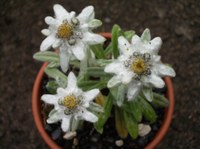Microsatellite development and chromosome evolution in Leontopodium (Asteraceae)
A joint project to explore the chromosome evolution of Edelweiss species

Speciation
in plants is the result of a complex 

In a joint project we aim at exploring the chromosome evolution of Leontopodium, the Edelweiss.
The genus Leontopodium
(Pers.) R. Br. (Asteraceae, Compositae) is one of the key genera for
the analysis of the impact of climate change on mountain floras. It is
economically important for both pharmaceutical and horticultural
purposes. This importance is contrasted by a lack of knowledge about
species coherence and species delimitations. One of the fundamental data
about species is the number of chromosomes and the possible indication
of polyploidy.
Sebastian Stille, Volker Wissemann
in collaboration with
- M. Jaeger, Botanical Garden Giessen, Germany
- W. B. Dickoré, Botanische Staatssammlung München, Ludwig Maximilian University, Munich, Germany
- T. F. Stuessy and S. Safer, Department of Systematic and Evolutionary Botany, University of Vienna, Austria
- H. Stuppner, Institute of Pharmacy/Pharmacognosy, Leopold Franzens University Innsbruck, Austria
